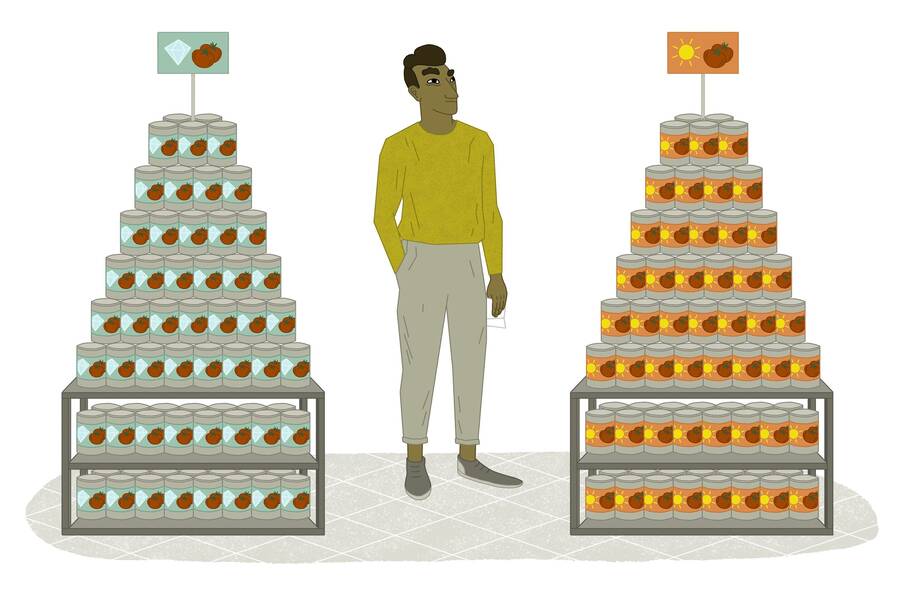Marketing Apr 1, 2023
We Prefer Authentic Products. But What Conveys “Authenticity”?
Invoking a company’s history can help—and research points to a new way of doing this.

Michael Meier
In 2017, Budweiser launched a campaign promoting their 1933 Repeal Reserve Amber Lager: a beer created from a company recipe developed shortly before Prohibition went into effect.
The resurrected brew was sold in a vintage bottle, and—as part of the launch—select customers in New York had the opportunity to ride past 1930s Prohibition landmarks in antique cars. In a statement from Anheuser-Busch, the company that makes Budweiser, the firm announced that the limited-edition product was “giving beer lovers the chance to experience and taste history.”
When Kent Grayson, an associate professor of marketing at Kellogg, learned of the campaign, he immediately recognized that the company was appealing to customers’ desire for authenticity. That is, rather than appearing responsive to fickle consumer demands or short-term profit-seeking, the company seemed to be staying true to itself. And when customers perceive a product as authentic, they’re often more likely to buy it or be willing to pay a higher price.
In a new study, Grayson and his colleagues investigated which aspects of a product evoke authenticity for consumers, focusing specifically on foods. They found that if a product was made using an original process designed by the founder, people felt that the food had a stronger intangible “essence” of the brand and was more authentic than if a newer process had been used to make it.
Essence is “an ineffable but important foundational quality of people and things that makes them what they are,” Grayson says. “It’s like DNA; it’s like a soul.”
JFK touched this watch!
A product can gain a sense of authenticity in multiple ways.
For example, in a 2014 study, one research team found that when study participants were told that a product was made at a company’s original factory, they thought the item had a stronger “essence” of the brand. And that stronger essence, in turn, heightened the product’s perceived authenticity.
While that research showed that a connection to a physical place can bestow authenticity, similar connections to people or times, can also do the trick. After all, people will pay a lot of money for memorabilia such as a watch worn by JFK. Or an Art Deco piece might be considered authentic because it was created during the 1920s.
Grayson and his colleagues, Chelsea Galoni at the University of Iowa and Brendan Strejcek at the University of Toronto, wondered if essence could also come from a firm’s original manufacturing process. Would products made with that process be seen as more authentic?
This would be significant because firms can manufacture many more items with an original process than they can at an original location, Grayson says. After all, a single factory can churn out only a limited amount per year.
The researchers hypothesized that the historical process might provide a sense of continuity—something that embodied the founder’s or company’s values—as well as a sense of conformity to the company’s overall standards. Both these factors have also been associated with authenticity.
To find out if using the original manufacturing process increased essence, the researchers ran an online study with 505 participants on the website MTurk. Each participant read background information about one of six companies: Oreo, Häagen-Dazs, Coca-Cola, Miss Vickie’s, Heinz, or Teavana. For example, the Häagen-Dazs story related how entrepreneur Reuben Mattus had immigrated from Poland to the United States in 1921, sold cold treats from a horse-drawn wagon, and eventually devised “the world’s first premium ice cream” with high-quality, natural ingredients.
Essence is “an ineffable but important foundational quality of people and things that makes them what they are. It’s like DNA; it’s like a soul.”
—
Kent Grayson
Participants then read that the firm was making a limited-edition product. Half of the group was told that the company would make the product using the founder’s original process at its newest factory. The other half were told that the product would be made using the firm’s newest process, designed by its chief product engineer, at its original factory.
Each person then rated aspects of the product’s essence on a scale of 1 to 9—for instance, how much it reflected the brand’s heritage or embodied the brand’s special quality. They also rated how much the item felt like a “genuine,” “true,” or “real” product from the company on a scale of 1 to 7, which the researchers combined into an overall authenticity score.
Paying a premium
The original process seemed to imbue products with at least as much essence and authenticity, in participants’ minds, as the historical factory did. People who thought the item was made at the original factory rated essence at 7.16, on average, and authenticity at 6.23. Participants who thought it was made with the founder’s process gave essence and authenticity ratings of 7.85 and 6.43, respectively. This result suggested that essence doesn’t have to come from a physical connection with a place.
The team got similar results when they ran another online study about Ghirardelli chocolates. Participants rated essence and authenticity higher when they read that the chocolate was made using a process established by founder Domingo Ghirardelli in 1849, even if the manufacturing took place at a new factory.
In that study, people also answered questions about how much they valued the product—for example, how likely they were to buy it, or whether they would pay a premium. Participants who were told about the original process gave an average valuation rating of 5.36 out of 9, while those who read about a new manufacturing process gave a rating of 4.93.
This doesn’t mean that people would pay a huge premium or travel 50 extra miles to get the chocolate made with the older process, Grayson says. But if they were casually browsing a supermarket shelf and saw the two products side by side, they might think, “I don’t know why, I’m just going to grab this,” he says. “But we know why. It has something to do with authenticity and with connection.”
A whiff of Ghirardelli essence
Finally, the team investigated what happened if a company “borrowed” an original process developed by another firm. Would the borrower also gain a stronger sense of authenticity?
The researchers ran another study using the same information about Ghirardelli, but this time they added a twist. Some participants read that Ghirardelli had licensed their chocolate mixing, tempering, and molding process to Godiva.
Among that group, half were told that the licensed process was Domingo Ghirardelli’s original process; others read that it was a new process developed by Ghirardelli’s chief chocolatier. Participants then rated how much the Godiva chocolate had the essence of Ghirardelli, and whether it was an authentic Ghirardelli chocolate.
The Godiva bar made with the original Ghirardelli process received higher ratings for Ghirardelli essence and authenticity, the team found. In reality, Godiva probably wouldn’t want their chocolates to have Ghirardellian essence because the two companies are direct competitors. “But there are business cases where having authenticity from someone else’s brand might be a plus,” Grayson says.
For example, one could imagine that if a snack company produced premade peanut-butter-and-jelly sandwiches, the firm could use Smucker’s jam, made with an original recipe. In this scenario, the two products are more complementary than competitive, and drawing on Smuckers’ essence would be a plus for the snack-maker.
Values over profits
The results suggest that companies can draw on their historical manufacturing processes to infuse products with a sense of authenticity.
But even newer companies may not be entirely out of luck. These firms could still potentially demonstrate authenticity by emphasizing continuity in other ways—perhaps by telling the story of their founder, Grayson says. For example, a surfing gear company could emphasize how its founder started surfing when she was a kid and has loved the sport for her whole life.
Or the firm could commit to an entirely different strategy for cultivating authenticity: it could go all in on corporate social responsibility and show “a sincere desire to make a change,” he says. Patagonia, for instance, is well-known for its commitment to sustainability. In 2011, the company ran an ad saying, “Don’t buy this jacket” on Black Friday to encourage people to reduce consumerism and to repair rather than replace items.
This type of statement shows that “we care so much about this that we’re willing to give up some profit,” Grayson says.
Roberta Kwok is a freelance science writer in Kirkland, Washington.
Galoni, Chelsea, Brendan Strejcek, and Kent Grayson. 2022. “The Role of Original Process in Creating Product Essence and Authenticity.” Journal of Consumer Psychology. (32): 680–686.



